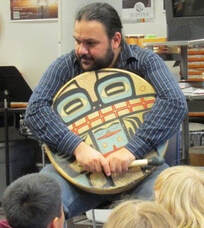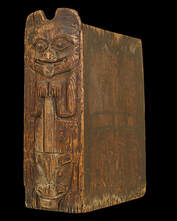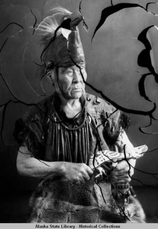Lingít Songs: Clan At.óowu
Lingít songs express the innermost feelings of an individual or group and is a form of storytelling. They are composed to mourn the dead, heal hostilities between clans, show appreciation and joy, honor individuals, teach life lessons and morals, soothe babies, placate the souls of slain animals, and invoke spiritual helpers. Lingít songs also document personal histories, as well as tribal histories, such as migration stories. These songs are highly valued by a clan and considered at.óowu or their most precious possessions, which means that only members of the clan can sing these songs. Any individual outside of the clan must gain permission to sing a clan-owned song. Childrenʼs songs and lullabies are not owned by clans and can be sung by the general public. Many of the songs in this unit are lullabies. For the remaining songs, permission was given by the composer.
de Laguna (1972) transcribed and published 103 Yakutat Lingít songs - the largest collection of Lingít music. The songs were organized into several categories.
de Laguna (1972) transcribed and published 103 Yakutat Lingít songs - the largest collection of Lingít music. The songs were organized into several categories.
- Proprietary Clan Songs: songs owned by the clan, which are often the oldest and most valuable songs detailing the clanʼs histories.
- Peace Songs: songs written to right a wrong committed against an opposite clan.
- Songs of Humor: included Raven songs sung as part of the festivities at a peace ceremony, as well as children teasing songs.
- Haida Mouth Songs: about a specific individual whose name is never mentioned in the song. Instead the personʼs clan is sung.
- Dance Songs: dances given by the guests after a potlatch to thank their hosts
- Walking Song or Marching Songs: sung by guests when coming by canoe to a potlatch or entering a hostʼs house
- Resting or Sitting Down Songs: sung while feasting after potlatch wealth has been distributed
- Childrenʼs Songs: lullabies and teasing songs, which anyone can sing and are composed by parents and grandparents.
Song Background: As Important as the Song Itself
The background and history of a Lingít song is just as important as the song itself and should be presented before singing it. To sing a song without acknowledging the composer, the clan and the person who taught you would be disrespectful. As part of this unit, students should be able to introduce the song by sharing its background before singing it. Below is a list all of the Lingít songs included in this unit, along with the answers to these questions, which must be answered and presented to the students before singing them.
|
|
Instruments
|
Lingít Drum or "Gaaw"
Deer hide stretched over wooden frame tightened with animal sinew crest often painted on drumhead Padded beater played on every beat based upon the rhythm of the song |
Lingít Box Drum
Steamed bentwood box Beaten with a fist or large drumstick on every other beat. |
Lingít Rattle
Ornately carved out of wood Made of pecten shells, pebbles, or wooden casings Tapping sticks (no image available) used during dancing and tapped to the beat of the drum |
Lingít Music Characteristics
- Form: strophic (both chorus and verse are sung to the same melody).
- Song structure: often chorus (two times), verse (two) chorus (one time), verse (two times) with traditional songs
- Chorus & Verse: chorus used vocables (sounds with no meaning) and verse, words.
- Role of the Song Leader: introduces the song, calls for the group to be ready, announces the skips, verses and vocables.
- Skips: For dramatic effect, drumming stops during certain points in the song allowing the voice and rattles to stand alone. They are called skips and usually occur during the chorus/vocables.
- Drummer: starts the song by providing an introduction, which is often a tremelo or fast beating tempo that imitates the sound of a rattle.
- Drum Patterns: box drum usually falls on the offbeat, while the hand drum beats on every beat.
- Balance & Respect: Song and dances are composed to recognize the opposite clan and to dance for their fatherʼs people. This maintains balance - an important tribal value. If an Eagle song is sung then a Raven song must be sung in response to achieve balance and vice versa.
REFERENCES:
- Johnston, T.F. (1977). Tlingit Music in Southeast Alaska. Anthropologie (1962-), 15(1), 65073.
- Johnston, T.F. (1992). The Socio-Mythic Contexts of Music in Tlingit Shamanism and Potlatch Ceremonials. the world of music, 34(2), 43-71.
- de Laguna, F. (1972). "Under Mount Saint Elias: The History and Culture of the Yakutat Tlingit: Part Two." Smithsonian Contributions to Anthropology. 1–1395. https://doi.org/10.5479/si.00810223.7.2
- Morrison, D. (1988). A descriptive analysis of Yakutat Tlingit musical style. University of Alaska Fairbanks.



